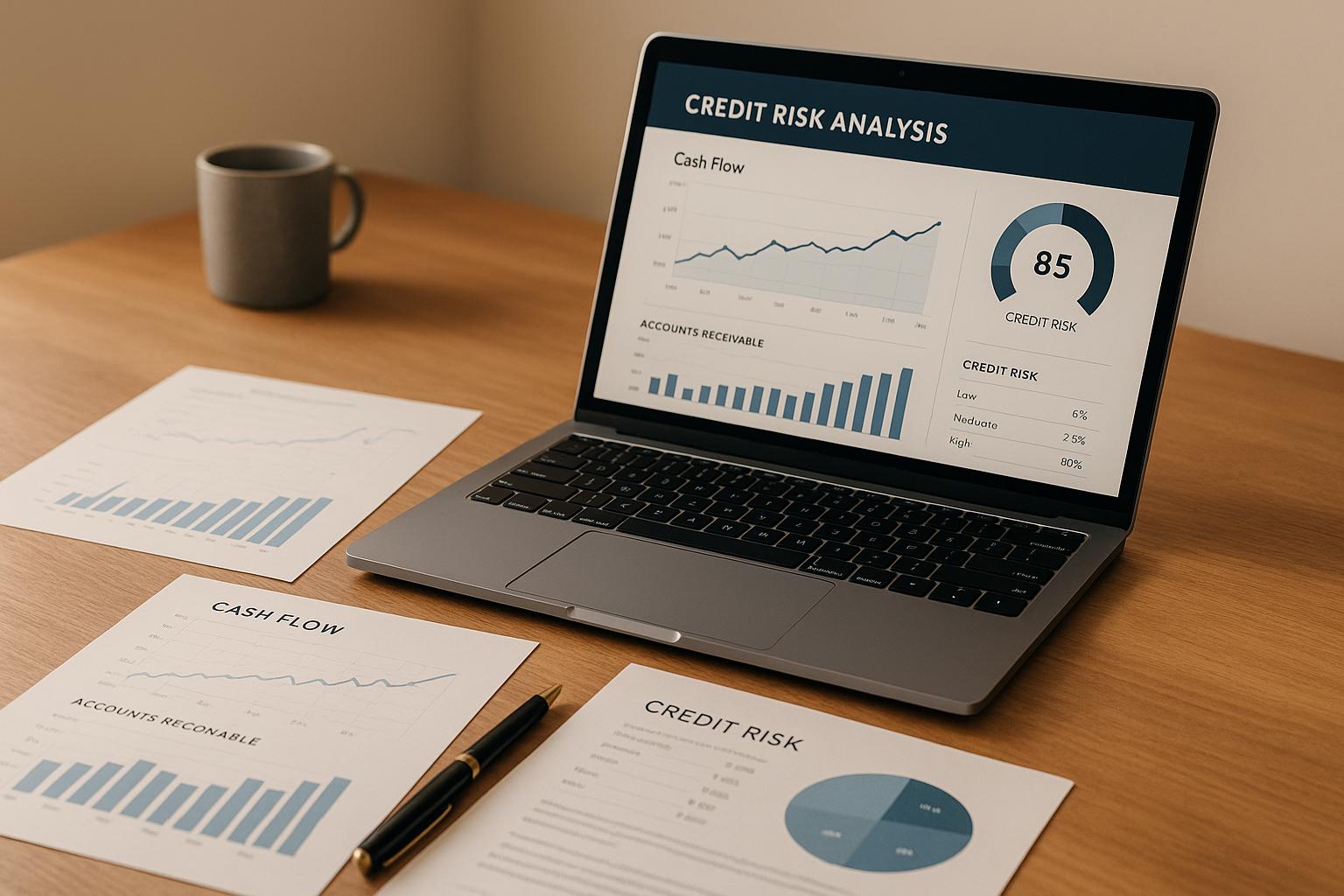5 Credit Risk Management Practices for Better Cash Flow

Credit risk management is crucial for maintaining steady cash flow, especially for growing businesses. Late or missed payments can disrupt operations, but with the right strategies, you can reduce risks and improve financial stability. Here’s a quick overview of five practices to manage credit risk effectively:
- Conduct thorough credit assessments: Evaluate customer creditworthiness beyond just credit scores to identify risks early.
- Establish clear credit policies: Define credit limits, payment terms, and approval processes to create consistency.
- Monitor credit in real time: Use tools to track customer financial health and spot issues before they escalate.
- Develop active collections plans: Address overdue payments promptly while maintaining customer relationships.
- Leverage technology and data integration: Automate processes and use data-driven insights for smarter decisions.
These steps not only reduce bad debt but also ensure a more predictable cash flow, helping businesses scale confidently. Let’s dive into how each practice works.
1. Conduct Complete Credit Assessments and Customer Due Diligence
Understanding your customers is the cornerstone of effective credit management. A thorough credit assessment means going beyond just reviewing a credit score. It involves analyzing a customer's financial history, current standing, and overall ability to meet payment obligations. This might include examining financial statements, vendor payment records, and the overall stability of their business.
A well-rounded evaluation should cover key elements like credit reports, debt-to-income ratios, payment history over the past 12 to 24 months, and even verifying business registration details. For B2B transactions, consider adding trade references and bank statements to the mix for a clearer picture.
It’s also vital to examine payment behavior patterns, as these insights help identify potential risks early on, laying the groundwork for smarter, proactive credit decisions.
Effectiveness in Reducing Bad Debt
Comprehensive credit assessments are a powerful tool for minimizing bad debt. By identifying high-risk customers early, businesses can make informed decisions about extending credit, requiring deposits, or setting stricter terms.
These evaluations help distinguish between customers dealing with temporary cash flow challenges and those facing deeper financial instability. This distinction is critical - it allows businesses to offer flexible solutions like payment plans to reliable customers while steering clear of riskier prospects.
Red flags, such as bankruptcies, liens, judgments, or a history of consistent late payments, often signal future payment issues. Spotting these warning signs early enables businesses to act before extending credit, reducing the likelihood of bad debt.
Impact on Cash Flow Stability
Thorough credit assessments contribute to more predictable cash flow by reducing late payments and defaults. When you understand your customers' payment habits and financial capacity, you can better anticipate when payments will arrive, allowing for more accurate financial planning.
This predictability is especially valuable for businesses in growth stages, where steady cash flow is crucial to funding operations and expansion. Knowing when payments will come in allows companies to meet their own obligations, negotiate better terms with suppliers, and avoid the need for costly short-term financing.
Additionally, setting credit limits based on a customer’s actual ability to pay ensures that debt doesn’t spiral out of control. This prevents payment delays or defaults, keeping cash flow steady and reliable.
Ease of Implementation for Growth-Stage Businesses
Starting with credit assessments doesn’t have to involve huge investments or complex tools. A simple, standardized process can go a long way in reducing risk.
Developing a clear checklist for credit applications is a great first step. This might include gathering essential documents, setting minimum credit score thresholds, and reviewing basic financial ratios. A straightforward process that takes just 30-60 minutes per application can help businesses avoid costly mistakes without requiring advanced expertise or expensive software.
For businesses new to formal credit management, focusing on essentials - like credit reports, trade references, and basic financial checks - can provide meaningful protection while keeping things manageable.
Scalability for Future Business Needs
A structured credit assessment process not only works for today but also grows with your business. The criteria and processes you establish early can later be integrated into automated systems, making it easier to handle higher volumes as your business expands.
Many businesses start with manual reviews of credit reports and financial documents, then transition to automated scoring systems as their needs grow. These systems maintain consistency while scaling up to handle more complex demands.
As your business evolves, you can also segment assessments by transaction size, customer type, or industry. This lets you allocate resources more efficiently - spending extra time on large, high-stakes deals while streamlining smaller, lower-risk transactions. By building on a strong foundation, your credit management practices can keep pace with your growth.
2. Set Clear Credit Policies and Limits
Once you've completed a detailed credit assessment, the next step is to establish clear credit policies. These policies should outline credit limits, payment terms, approval processes, and the consequences of late payments. Think of them as your rulebook for extending credit - without clear rules, decisions can quickly become inconsistent or reactive, which can hurt your business in the long run.
Your policies should explicitly define credit limits, specify who has the authority to approve them, and detail payment terms to ensure consistency. For example, lower-risk customers might qualify for automated approvals up to a certain amount, while higher credit limits or customers with limited histories might need management review.
Standardizing payment terms - like Net 30, Net 15, or requiring upfront payments - can help prevent confusion and make collections more straightforward. This clarity not only simplifies internal processes but also provides a solid foundation if disputes or collection issues arise.
Effectiveness in Reducing Bad Debt
Clear credit policies reduce risk by enforcing objective criteria based on the credit assessments you've already conducted. When credit limits are tied to a customer's actual financial capacity, rather than gut feelings or sales pressure, you're less likely to overextend credit that can't be repaid.
Documenting these policies ensures credit decisions are made objectively and consistently, which helps prevent overextension. Regularly reviewing these policies is just as important. For instance, a customer who qualified for a $50,000 credit limit two years ago might now be facing financial challenges. Periodic reviews can catch these changes early, helping you avoid larger collection issues down the road.
Impact on Cash Flow Stability
Having structured credit policies in place can stabilize your cash flow by encouraging predictable payment behavior. When customers know exactly what’s expected of them, they’re more likely to prioritize paying your invoices on time.
Capping individual customer exposure is another way to protect your cash flow. Imagine if one customer accounts for 40% of your outstanding invoices and suddenly faces financial trouble - that could leave your cash flow in a precarious position. By setting caps on how much credit you extend to any one customer, you can spread risk more evenly across your client base.
You can also implement tiered credit structures to encourage faster payments. For instance, you could offer a 2% discount for payments made within 10 days, stick to standard Net 30 terms for established customers, and require deposits from new accounts. This approach rewards prompt payments while keeping risk under control.
Ease of Implementation for Growth-Stage Businesses
Setting up credit policies doesn’t have to be complicated, even for growing businesses. Start with a straightforward document that outlines your credit limits, payment terms, approval processes, and escalation procedures. This simple step can bring immediate clarity and consistency to your credit decisions.
Begin by documenting your current practices and identifying areas where inconsistencies exist. Many businesses in their growth phase discover that applying different terms to similar customers leads to confusion - or worse, legal problems. Standardizing these practices can eliminate such issues and provide an immediate benefit.
For starters, focus on defining basic policies, such as credit limits, required documentation, and standard payment terms. Over time, as you gain experience, you can introduce more advanced elements, like terms tailored to specific industries or adjustments for seasonal fluctuations.
If you're unsure where to begin, seeking expert advice can make a big difference. Financial advisory firms, like Phoenix Strategy Group, specialize in helping businesses create tailored credit policies that align with their unique needs.
Scalability for Future Business Needs
Well-thought-out credit policies can grow alongside your business, offering a framework that adapts to increasing volume and complexity. The approval hierarchies and documentation processes you establish now can later be integrated into automated systems or workflow management tools.
As your market evolves, you can adjust your policies without starting from scratch. For example, you might introduce specific terms for international customers, create separate guidelines for different product lines, or develop criteria tailored to your industry - all while keeping the core framework intact.
Having these policies documented also makes onboarding new employees much easier. Clear, written procedures show operational maturity and ensure that your credit management practices are consistent, even as your team grows. Plus, these scalable policies lay the groundwork for incorporating technology and data-driven strategies, which we’ll explore in the next section.
3. Use Real-Time Credit Monitoring and Early Warning Systems
Once you've established solid credit policies, the next step is to actively monitor your customers' financial health in real time. Real-time credit monitoring goes beyond the initial credit check - it continuously tracks changes in your customers' creditworthiness and flags potential issues before they impact your cash flow.
These systems keep an eye on credit bureau reports, public records, financial statements, and payment behaviors. If a customer's risk profile shifts - perhaps due to late payments to other vendors, legal troubles, or a downturn in their financial performance - you'll receive immediate alerts, allowing you to respond proactively.
The real value of real-time monitoring lies in its ability to shift your credit management approach from reactive to proactive. Instead of waiting for a missed payment to uncover a problem, these tools help you spot warning signs early, giving you time to adjust your strategy and reduce the risk of bad debt.
Effectiveness in Reducing Bad Debt
Real-time monitoring systems are excellent at identifying early signs of financial trouble that might otherwise go unnoticed. For example, they can detect patterns such as a customer gradually taking longer to pay or changes in their industry's financial outlook.
Common early warning signs include delayed payments - like a customer who usually pays within 15 days suddenly taking 30 days - an uptick in credit inquiries from other lenders, changes in their business registration, or negative news about the company or its industry.
When these red flags appear, you can act quickly by tightening credit terms, asking for additional documentation, or even placing the account on hold until the situation stabilizes. Acting early can significantly reduce the likelihood of needing to write off unpaid invoices.
These systems also provide insights into broader market trends, allowing you to adapt your strategy based on evolving risks.
Impact on Cash Flow Stability
By reducing surprises in payment behavior, continuous monitoring helps create a more predictable cash flow. When you’re aware of which customers are facing financial stress, you can adjust your collection strategies and payment terms to minimize risk.
For instance, if a major customer shows signs of financial trouble, you might require partial prepayment for new orders or switch to more frequent payment schedules to limit exposure. These adjustments ensure that your cash flow remains steady, even when some customers face challenges.
Additionally, the data gathered from these systems helps improve your cash flow forecasting. By combining historical payment patterns with current risk indicators, you gain a clearer understanding of when payments are likely to come in, making financial planning far more accurate.
Ease of Implementation for Growth-Stage Businesses
Modern credit monitoring tools are designed to be easy to implement, even for businesses in the growth phase. Many solutions integrate seamlessly with your existing systems and can start tracking customer risk within days.
A practical way to begin is by focusing on your largest or highest-risk customers first, then gradually expanding monitoring to include your entire customer base. This phased approach allows you to refine your processes without being overwhelmed by alerts.
Most tools let you customize alert thresholds, so you can set the sensitivity level that suits your business. For example, you might start with broader alerts and then fine-tune them over time as you become more familiar with the types of changes that truly impact customer payment behavior.
Setting up typically involves uploading your customer list and configuring alert preferences. Many systems can automatically match your customers to their credit profiles, although manual checks may be needed for more complex cases.
Scalability for Future Business Needs
As your business grows, credit monitoring systems can scale effortlessly to accommodate new customers. These platforms often integrate with your CRM, accounting software, and other business tools via API, eliminating the need for manual data entry and ensuring that credit decisions are always based on up-to-date information.
With growth, these systems also offer advanced features like portfolio risk analysis, industry trend tracking, and predictive modeling. These capabilities help you make more informed and strategic decisions as your credit management needs evolve.
The ability to scale ensures that your cash flow remains stable as your customer base expands. Over time, the reporting features of these systems become even more valuable, offering insights into customer payment habits, industry trends, and the effectiveness of your credit policies. This data can guide larger strategic decisions, such as which markets to focus on or how to refine your customer acquisition strategy.
4. Create Active Collections and Recovery Plans
Real-time alerts are great for spotting potential payment issues early, but they’re just the start. To truly protect your cash flow when payments lag, you need active collections and recovery plans. These proactive strategies work hand-in-hand with solid credit assessments and real-time monitoring to create a well-rounded credit management approach.
Unlike passive methods that simply wait for payments to roll in, active collections involve clear, systematic steps to recover overdue payments while keeping customer relationships intact. The process begins before payments are overdue by setting clear expectations, opening strong communication lines, and having well-documented procedures for every stage of the collections process.
It’s important to note that active collections aren’t about being aggressive. Instead of jumping to harsh measures, this approach focuses on understanding the reasons behind late payments and collaborating with customers to find workable solutions. The goal? Recover your money while keeping the customer relationship intact.
Effectiveness in Reducing Bad Debt
The earlier you tackle overdue payments, the better your chances of recovering the full amount. Active collections help reduce bad debt by addressing payment issues before they spiral out of control. Timing is everything here.
A structured process might start with a friendly reminder email or call within five days of a missed payment. If the payment remains overdue, follow up with more formal communication. Each step has a purpose: gathering details about the customer’s situation, reinforcing their payment obligations, and documenting your efforts.
This consistent follow-up often uncovers simple problems - invoice disputes, address changes, or temporary cash flow hiccups - that can be resolved quickly. Plus, keeping detailed records of these efforts not only helps reduce bad debt but also provides valuable insights for future decisions and, if necessary, legal protection.
Impact on Cash Flow Stability
Active collections make cash flow more predictable by shortening the time between invoicing and payment. When customers know you’ll follow up promptly, they’re more likely to prioritize paying your invoices.
Recovery plans also play a key role. They convert potential bad debts into structured payment arrangements, ensuring a steady stream of cash while preserving the customer relationship. Though it may take longer to collect the full amount, these plans provide a sense of predictability.
Regular, professional follow-ups also improve customer payment habits. Many customers would rather avoid the extra hassle of follow-up communications and pay on time instead. Over time, this helps you forecast cash flow more accurately, as you can rely on historical recovery rates and track where each account stands in the collections process.
Ease of Implementation for Growth-Stage Businesses
Starting an active collections process doesn’t have to be complicated. For smaller or growing businesses, simple tools like spreadsheets and calendar reminders can get the job done. The key is having a clear collections policy that outlines when and how you’ll contact customers about overdue payments. This includes timelines for follow-ups, communication methods, and escalation procedures for unpaid accounts.
A professional yet persistent approach works best. Make sure your team follows the policy consistently and documents every interaction. Automated features in many accounting software platforms - like payment reminders and aging reports - can handle routine tasks, freeing you up to focus on larger or more complex accounts.
It’s often wise to prioritize your largest overdue accounts first. Successfully collecting on just a few high-value accounts can have an immediate, positive impact on your cash flow while you refine your approach for smaller balances.
Scalability for Future Business Needs
As your business grows, your collections process should evolve to keep up. Starting with manual tracking is fine, but over time, you can transition to more advanced systems. These systems can automate reminders, escalate delinquent accounts based on specific criteria, and even integrate with your customer relationship management (CRM) tools.
Sophisticated collections platforms allow you to segment customers by payment history, account size, or risk level. This means you can tailor your strategy - offering personalized attention to high-value customers while automating follow-ups for smaller accounts.
The data you gather from a structured collections process becomes increasingly useful as your business expands. You’ll notice trends in customer payment behavior, seasonal patterns, and the best times to reach out. This insight helps refine your credit policies and improve customer selection.
Scalable systems also support multiple communication channels - email, phone, text, and even traditional mail - so you can connect with customers in the way they prefer. By integrating collections with your accounting and CRM systems, you ensure that all teams - sales, customer service, and collections - stay aligned, avoiding any confusion or mixed messages.
As your team grows, it’s worth designating specific staff members to handle collections. Specialization not only improves recovery rates but also ensures that your team’s time is used efficiently and effectively.
sbb-itb-e766981
5. Use Technology and Data Integration for Better Credit Management
Gone are the days when credit management relied solely on spreadsheets. Today, businesses are using integrated technology to combine data from accounting systems, CRM platforms, and external credit databases. This approach not only saves time but also provides a clearer picture of financial risks, enabling smarter credit decisions and safeguarding cash flow.
By linking data from various sources - like your accounting software, bank accounts, and external credit reports - you can get a complete view of a customer’s financial health and payment habits. Real-time insights allow you to make proactive decisions, reducing risks before they impact your business.
The key is to choose tools that integrate seamlessly. When your systems can automatically pull and cross-reference data, you eliminate manual input errors and free up your team to focus on strategy. This kind of integration transforms credit management into a more efficient and precise process.
Effectiveness in Reducing Bad Debt
Integrated systems equipped with advanced analytics can identify risk patterns. For example, machine learning algorithms analyze payment histories, industry trends, and economic data to predict which customers are likely to default. With this knowledge, you can adjust credit terms or require additional security for high-risk clients.
Automated scoring models also keep you updated in real time. If a customer’s credit rating drops or they start paying other vendors late, the system will flag it immediately. This allows you to take quick action, such as reducing their credit limit or asking for upfront payments on new orders.
Combining your internal payment data with external credit reports and industry benchmarks gives you a well-rounded risk assessment. This ensures you’re not extending credit to customers who may appear reliable on paper but have underlying financial issues.
Impact on Cash Flow Stability
Automation plays a big role in stabilizing cash flow. Tools like real-time dashboards and automated aging reports make it easier to monitor metrics like days sales outstanding (DSO) and collection rates. Instead of waiting for month-end reports, you can track trends daily or weekly, allowing you to address issues before they escalate.
Integration with banking systems also speeds up processes like payment reconciliation. When payments are automatically matched to invoices, you get instant updates on customer payments. This real-time information helps you adjust cash flow forecasts more accurately and eliminates delays in updating records.
Ease of Implementation for Growth-Stage Businesses
For smaller or growing businesses, implementing advanced credit management tools doesn’t have to be overwhelming or costly. Many modern accounting platforms, such as QuickBooks Online and Xero, come with built-in features like credit tracking and automated payment reminders. These tools provide a solid starting point without requiring a big upfront investment.
If you’re ready for more advanced capabilities, specialized credit management platforms can integrate with your existing systems using APIs. This means you don’t need to replace your current setup - just enhance it. The process typically begins by connecting your accounting system to pull historical payment data, which most platforms can do automatically. From there, you can set up workflows for tasks like credit approvals, payment reminders, and risk monitoring.
Companies like Phoenix Strategy Group specialize in helping growth-stage businesses implement these systems. They offer data engineering services to connect different platforms and create custom dashboards, giving you real-time insights into credit risk and cash flow.
Scalability for Future Business Needs
One of the biggest advantages of technology-based credit management is its ability to grow with your business. Cloud-based platforms can handle increasing transaction volumes while continuously updating risk assessments and cash flow forecasts.
These systems often offer modular features, so you can start with basics like credit scoring and payment tracking. As your needs evolve, you can add functionalities like automated collections workflows, customer portals, or integration with multiple banks and payment processors. This flexibility allows you to expand without disrupting your existing operations.
For larger businesses, enterprise-level solutions offer advanced analytics and reporting tools. Over time, as your data grows, these systems use machine learning to identify subtle patterns and provide even more accurate predictions. They adapt to your specific business needs, becoming more effective the longer you use them.
As your business scales, integration capabilities can also expand. You can connect your credit management tools with inventory systems, customer service platforms, and business intelligence tools. This creates a unified view of customer relationships, helping you make better decisions around credit terms, pricing, and retention strategies. By adopting scalable, integrated systems, businesses can ensure long-term cash flow stability and continue to manage credit risks effectively.
Comparison Table
Compare key metrics to understand how automated systems outshine manual credit management.
| Metric | Manual Credit Management | Automated/Technology-Driven Credit Management |
|---|---|---|
| Processing Speed | Takes days to weeks for credit decisions | Real-time or within hours |
| Risk Assessment Accuracy | Prone to human error and subjective judgment | Consistent, data-driven, and highly accurate |
| Cash Flow Impact | Delayed collections lead to higher DSO | Faster collections reduce DSO |
| Days Sales Outstanding (DSO) | Often 45-60+ days | Reduced by 20-30% (typically 30-42 days) |
| Bad Debt Write-Offs | Higher risk due to delayed detection | Up to 50% fewer write-offs |
| Early Warning Detection | Reactive, periodic reviews (monthly or quarterly) | Real-time alerts for proactive management |
| Resource Requirements | Labor-intensive, requires significant manual data entry | Minimal manual effort, allowing strategic focus |
| Scalability | Limited, needs proportional staff increases | Easily scalable with minimal additional effort |
| Data Integration | Siloed systems requiring manual entry | Seamless integration with ERP/accounting systems |
| Processing Time Reduction | Baseline | Cuts manual tasks by up to 70% |
This table highlights how automation offers speed, accuracy, and scalability that manual systems simply can't match.
One of the standout advantages of automated systems is the dramatic improvement in response time. While manual methods might take days to finalize credit decisions, automation provides real-time alerts. This means businesses can act immediately - adjusting credit terms or requiring upfront payments for customers flagged as high-risk - ultimately safeguarding cash flow.
Automation also leverages a wide array of data sources, such as credit bureau reports, bank records, industry benchmarks, and transaction histories. This comprehensive approach ensures consistent and reliable risk assessments, even when managing hundreds of customers. Manual processes, by contrast, often fall short when it comes to analyzing such vast and varied data.
Scalability is another key benefit. Automated systems can handle a growing customer base without the need for additional staff, making them particularly valuable for companies experiencing rapid growth.
For businesses considering the shift to automation, the benefits extend beyond efficiency. By integrating financial systems, companies can achieve measurable improvements in cash flow management. For instance, Phoenix Strategy Group specializes in bridging the gap between manual and automated processes. Their expertise in system integration ensures a smooth transition, while their fractional CFO services provide the strategic insight needed to maximize these financial gains.
Although manual processes might seem more cost-effective initially, hidden expenses - such as labor, delayed collections, and higher write-offs - quickly erode those savings. Automation not only reduces labor costs but also accelerates collections and minimizes bad debts. Most businesses see a return on investment within six to twelve months, making automation a smart financial decision in the long run.
Conclusion
Managing credit risk effectively is a cornerstone for maintaining steady cash flow and driving long-term growth. The strategies outlined in this article - from evaluating customers to streamlining collections - work together to reshape how businesses handle credit.
The numbers back this up. For instance, the Association for Financial Professionals found that businesses with strong credit risk management practices can cut their days sales outstanding (DSO) by as much as 20%, boosting cash flow significantly. Similarly, a 2023 Dun & Bradstreet survey revealed that 60% of businesses saw better cash flow after adopting automated credit monitoring and collection tools.
Technology has become a game-changer in this area. Automated systems speed up collections, reducing the time it takes to receive payments. But it’s not just about faster payments - it’s about shifting from a reactive approach to a proactive one. By identifying credit risks early, businesses can adjust terms or recovery strategies before small issues snowball into major problems.
For growing companies, structured credit processes are especially valuable. They provide the stability needed to scale while confidently extending credit to new customers. According to the National Small Business Association, over 30% of small businesses point to late payments and bad debts as key cash flow challenges - issues that proper credit risk management can help solve.
For businesses ready to take the next step, Phoenix Strategy Group offers tailored solutions to integrate advanced credit risk systems. These tools and processes can help optimize operations and deliver tangible improvements in cash flow and financial stability.
FAQs
What are the best ways to use technology and data to improve credit risk management?
To improve credit risk management using technology and data, businesses should first assess their existing systems to pinpoint areas that need improvement. Introducing tools that utilize real-time data, predictive analytics, and AI-powered insights can make a big difference in monitoring risks and making informed decisions.
Relying on varied and trustworthy data sources is key, along with implementing robust data governance practices to maintain data quality and security. Integrating these technologies into your workflows can help simplify operations, minimize financial risks, and enhance cash flow management.
How can real-time credit monitoring systems improve cash flow stability?
Real-time credit monitoring systems provide businesses with immediate insights into customer creditworthiness and payment habits. This means companies can quickly spot potential risks, like late payments or defaults, and take steps to address them before they escalate.
With stronger control over receivables, businesses can safeguard their cash flow, make smarter financial decisions, and reduce uncertainties. These advantages help ensure financial stability and support sustainable growth for companies looking to expand.
How can businesses recover overdue payments without damaging customer relationships?
Businesses can address overdue payments effectively while keeping customer relationships intact by emphasizing empathy, clear communication, and professionalism. When you approach customers with respect and acknowledge their financial difficulties, it helps maintain trust and goodwill.
Rather than resorting to aggressive methods, offering flexible options like payment plans can go a long way in building long-term loyalty. This thoughtful approach ensures payments are resolved without risking important client connections.




